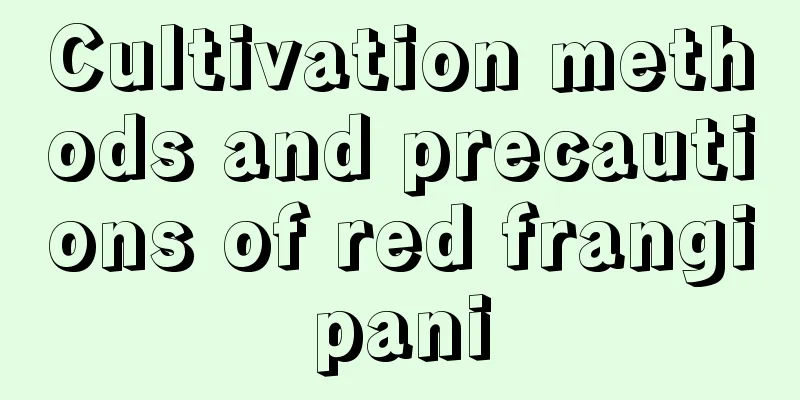Cultivation methods and precautions of red frangipani

1. Maintenance methods1. Temperature: Since the origin of red frangipani is in South America, it prefers higher temperatures. Specifically, the most suitable temperature is between 20 and 26 degrees. In addition, its cold resistance is not very good. If it is kept in an environment below eight degrees for a long time, it will freeze, so special attention should be paid. 2. Light: Plumeria is a sun-loving tree species, which means it has high requirements for sunlight. It can also grow in semi-shade conditions, but the growth will be slower. If it is in complete shade, it may grow leggy and produce very few or no flowers at all, so provide good light. 3. Watering: Red frangipani likes moisture, and watering can be adjusted according to its growth status. When the growth rate is fast, sufficient water needs to be added to meet its higher demand. But when it is basically not growing, you can't water it too much. 4. Fertilization: Adding appropriate amount of fertilizer will help its growth and flowering. Generally speaking, once every half a month is more appropriate. During the flowering period, pay attention to adding phosphorus fertilizer. 2. Breeding techniques1. Reproduction: It can be propagated by cuttings. In the south, it usually takes place in January or February. In the north, it is suitable from June to August. Select strong branches that are 20 to 30 centimeters in length. After cutting them, place them in a well-ventilated place to dry for two or three days before inserting them. It can be inserted into a sand bed or a sand basin. The temperature should be between 18 and 25 degrees, and the humidity should be between 65 and 75 percent. It will take about three weeks for the roots to form. 2. Repotting: The plant's growth trend is still very fast, so try to repot it once a year. It is better to change it in spring. In addition to choosing the right soil, you also have to mix a certain amount of base fertilizer such as bone meal into it. 3. Problem diagnosis and treatment1. Diseases: The most common one is angular spot disease, which occurs more frequently on leaves. Bordeaux can be used for treatment, and some fertilizer needs to be added in appropriate amounts. 2. Pests: The two most common ones are red spider mites and scale insects. It can be controlled by using pesticides such as cypermethrin. IV. Other issues1. Flower language: The flower language and meaning of red frangipani are all very good. Specifically, its flower language includes "resurrection" and "hope". 2. Can it be raised at home? It has good ornamental value, so it can be raised at home. |
<<: Cultivation methods and precautions of red gentian
>>: The cultivation methods and precautions of Red Prince Weigela
Recommend
How often should I water the money tree? How often should I water it?
How often should I water my money tree? How often...
The succulent plants grew into grape clusters with shiny leaves, which made the neighbors envious!
Red berries Red berries are a mini version of rai...
How to raise the lotus
How to care for the lotus illumination When growi...
What plants should be placed in the living room to bring wealth and good health to the whole family?
1. Lucky Bamboo Lucky bamboo itself is very beaut...
What vegetables are suitable for growing in summer? What vegetables are best to grow in summer?
June is the hottest time of the year. People ofte...
How to repot Chiva Lotus
It is very simple to repot a Chiva plant. Here we...
Does Kalanchoe like the sun?
Kalanchoe likes the sun Kalanchoe is a sun-loving...
The role of sage in Western cuisine
Food Pairing In Western cooking, sage is often us...
How to reproduce soapwort
Selection of branches Today I will mainly introdu...
How to water azalea
one. Water Quality: Be sure not to use alkaline w...
How long is the growth cycle of chicory?
Introduction to Chicory Growth Chicory mostly gro...
How to grow Nine-headed Lion Grass
1. Soil Nine-headed lion grass is more suitable f...
Garlic vine cultivation methods and precautions
Garlic vine is an evergreen climbing plant that o...
Does the Chinese Crabapple prefer shade or sun?
Does the Chinese Crabapple prefer shade or sun? T...
Silver Star Seasonal Maintenance
Silver Star's Four Seasons Maintenance: Sprin...









